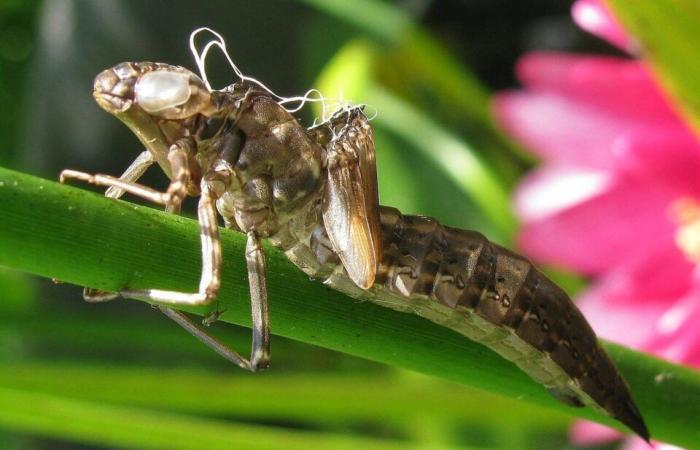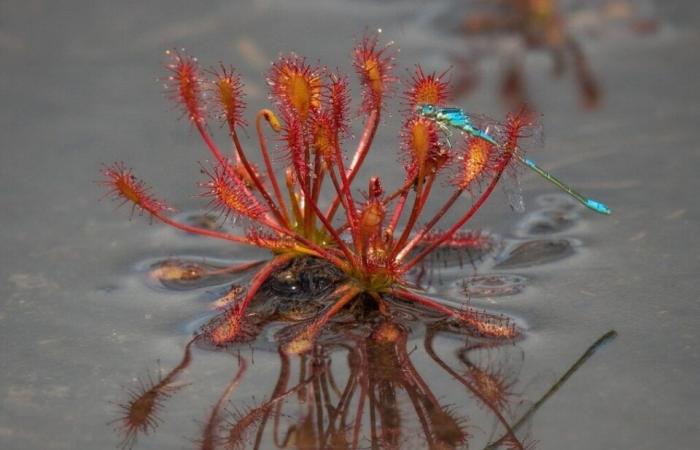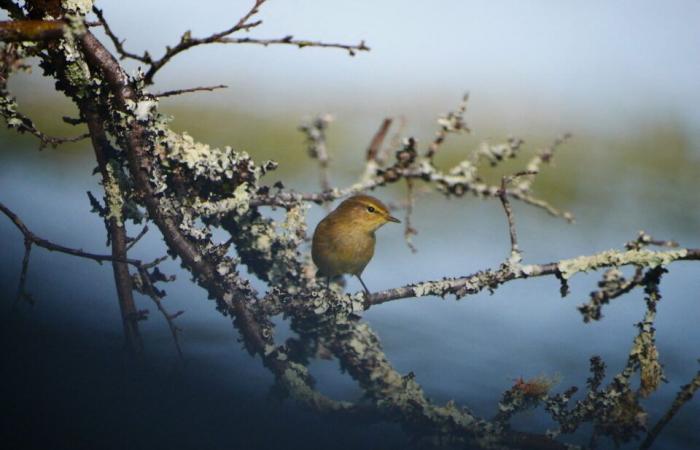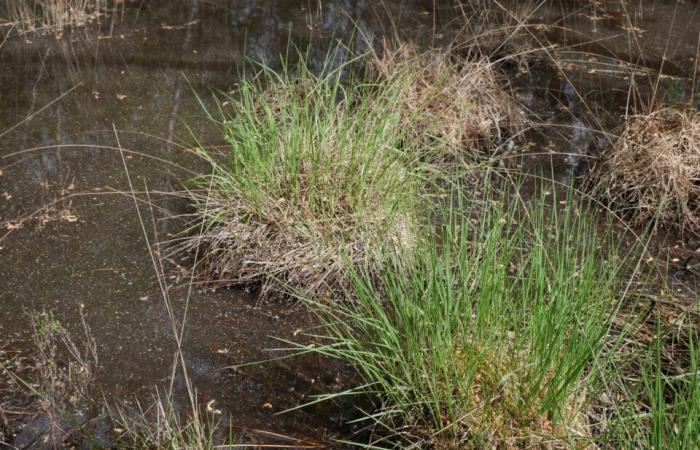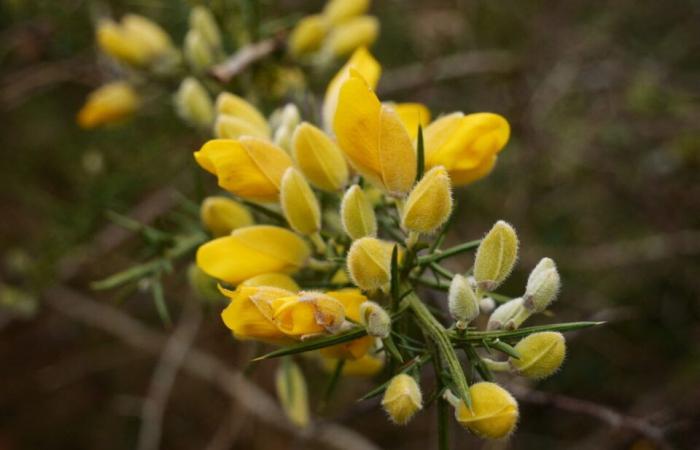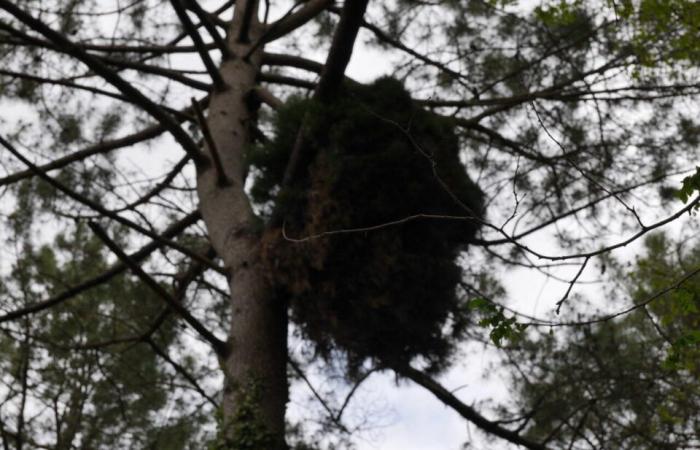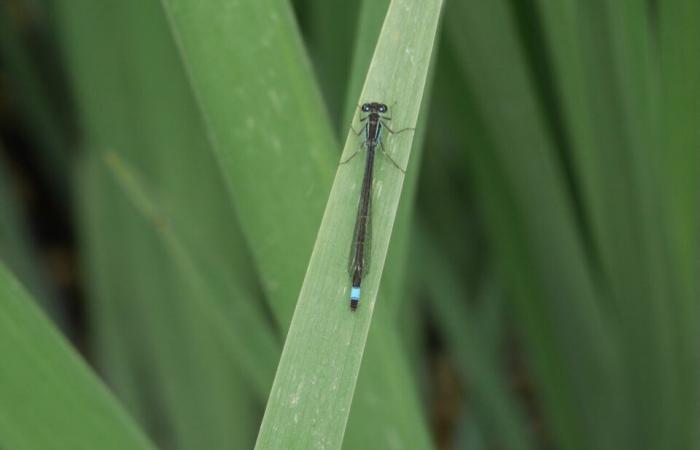By
Delphine Decourcelle
Published on
June 15, 2024 at 7:50 p.m.
This season, Gilo Nature takes you to observe some oddities of the fauna and flora around the “blue lake” of Hostens (Gironde). These originalities are quite observable elsewhere in Gironde and Lot-et-Garonne in spring or summer.
With the help of Fanny Christian, facilitator at the Department of Gironde, here we explain to you the why and how of these phenomena or specimens. Happy discoveries and keep your eyes peeled during your next walks, to try to find these little peculiarities of nature!
Blue Lake Loop: 3 km
The Blue Lake loop, offered as a guided tour by a naturalist guide, is approximately 3 kilometers long.
On the large map above, on the left, the loop is located on the circle “you are here”, at the letter E. Departure from the Relais Nature d’Hostens.
This circuit is not signposted. Other guided walks are offered by the Gironde department.
Little “monsters” that inspired the film Alien
In spring, we can notice small empty shells, sort of monster masks clinging to the leaves of wetlands. These are exuviae.
The growth of a dragonfly occurs through a succession of moults and the last one is liberating: it allows the larva to become a flying insect.
He then abandons his empty shell, its exuvia and this larval remains remain suspended from the leaves.
Some dragonflies, large predators, have something like an arm on their face. The monster from the film Alien was actually inspired by the dragonfly larva!
Drosera intermedia, this funny plant that eats insects
Did you know ? There are carnivorous wild plants on our territory!

This one (our photo), the Drosera (in Greek, morning dew) intermedia grows in water. Small (5-15 cm high), it feeds on “food supplements” of insects, because “it needs nitrogen which it finds in insect proteins” explains Fanny.
At the “blue lake” of Hostens, we also find Drosera rotundifolia. The insects become “trapped” in its leaves and the plant then takes several days to digest them.
We can also observe as endemic species on acidic and peat environments: Utricularia vulgaris, with yellow flowers.
How to recognize a pond turtle from a Florida turtle?
They often bask in the sun but do you know how to differentiate the Florida Turtle from the European Pond Turtle?

Fanny’s tips: “the first, as an adult, has red temples and yellow lines on the neck (our photo) while the Cistude just has yellow dots or spots. Adults, they are almost the same size (25 cm in diameter/carapace). »
“They compete for food and nesting areas. But Florida doesn’t eat Cistude, it’s an aberration. And the older they get, the more they tend to become vegetarian.”
Tsip tsap, listen to the birdsong
Will you recognize this insectivorous bird with its thin beak, eyebrow line and dark legs (our photo)?
“Its characteristic song tsip tsap tsip tsap tsup tsip is one of the first that we hear in spring” underlines the nature presenter. It’s about swift chiffchaff !

Around the blue lake, have fun spotting the blue or great tit, or the triple-banded wren in their kingdom of conifers!
The heathers reign supreme around the blue lake
They are queens around the “blue lake” of Hostens: the heathers! Acidic soil subshrubs with tiny leaves and pendulous flowers bell-shaped !

In Hostens, you can see the broom heath Erica scoparia (better known by its local name, “brande”), ash Erica Cinereathe ciliate Erica ciliaristhe false heather callune Calluna vulgarisand the four-cornered heather Erica tetralix.
Why is this lake nicknamed the blue lake and why this color?
The lake nicknamed “blue” is sometimes blue-turquoise, green and can even have red tones. Do you know what gives it these different colors?

The “blue lake” is a small lake located near one of the five large lakes of Hostens, Lake Lamothe. The “blue lake” includes full of pretty reflections.
When we look through binoculars, we can see burgundy red tones which would be linked to plants in the water, notably moss or algae, and in other places, turquoise tones linked to cyanobacteria.
“Cyanobacteria are microorganisms that have been present on Earth for two to three billion years and they are the first organisms to have produced oxygen ! » specifies ANSES (National Agency for Food, Environmental and Occupational Health Safety).
Touradons, these funny plant bumps
So what are these tufts of vegetation that grow on mounds?

These bumps are called turadons. It is an accumulation of plants, such as sphagnum moss (peat moss) or dead leaves, which decompose slowly because they are present in an acidic environment.
A turadon grows about 0.1 mm per year, so its height gives an indication of its age. And the molinia is a grass that grows on it.
A protected butterfly, the Fadet des sedges
The plants it likes to live in generally grow in humid areas. The Fadet des laiches, a pretty little butterfly protected at national and European level, has a very short lifespan of around two weeks.

It can be observed between June and July. Quite vulnerable and threatened with extinction, it likes open spaces to reproduce. The caterpillar spends the winter in the turadons of the blue moss, presented above.
Gorse flowers with a coconut scent
I had never really looked at the gorse flowers, although they were so beautiful with their sunny yellow color (hence their nickname “golden flowers”)!
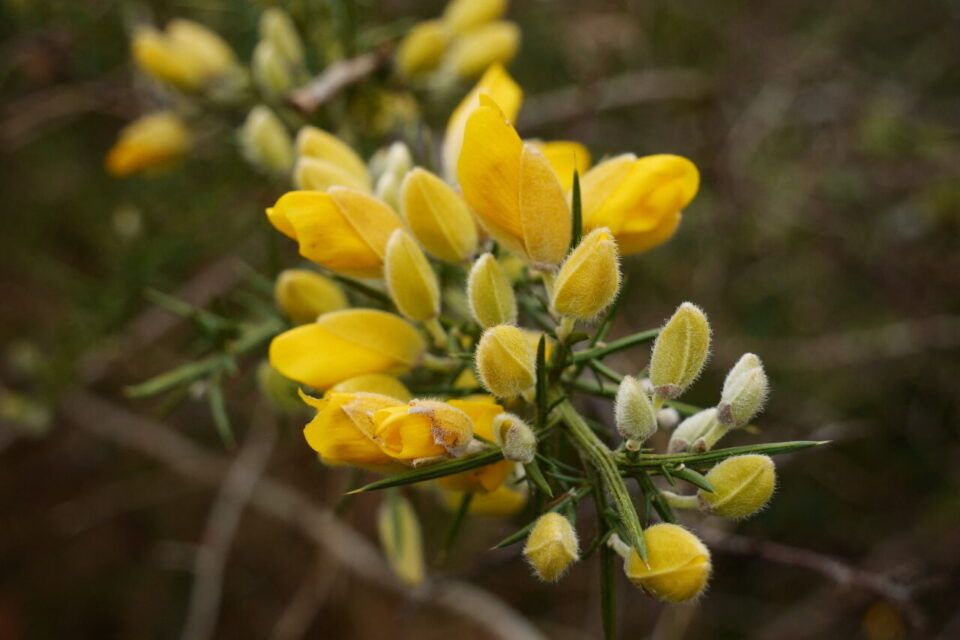
Well, imagine that at the peak of flowering, between April and June, the flowers exude a sweet and exotic scent reminiscent of coconut! Mixed withpowerful smell softwoods, earth, mushrooms… in short, everything that makes the moors magical…!
But be careful not to smell the gorse flowers too closely… because the plant has robust thorns, which can leave beautiful scratches!
Witches’ nests hanging above our heads
We have all already wondered what this strange agglomeration of branches clinging to certain conifers like pines was, forming sort of large balls and resembling a huge bird’s nest.
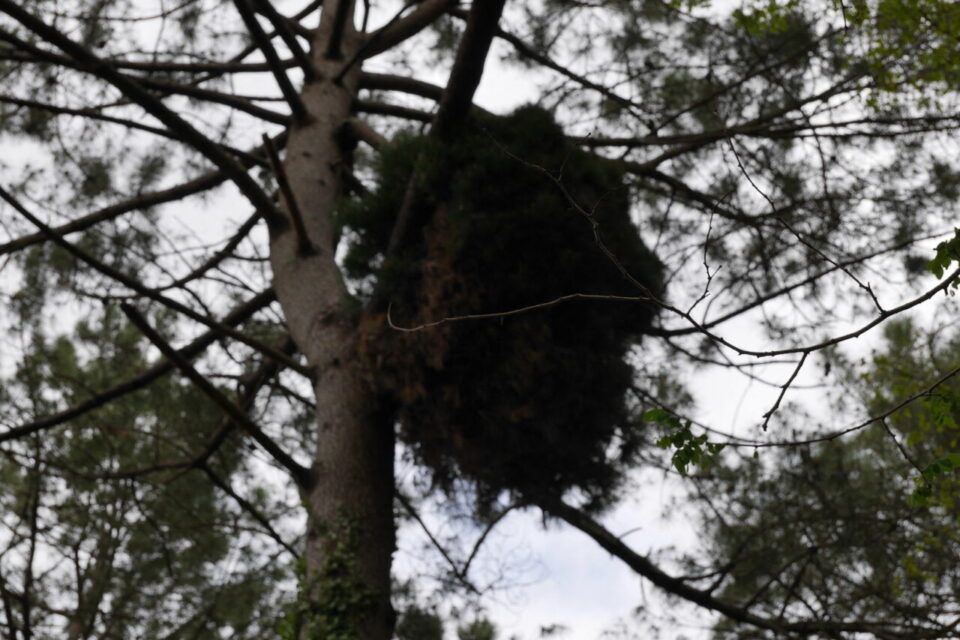
“We often call them “witches’ nests” says Fanny Christian, naturalist guide.
They can be caused by different organisms: mites, insects, fungi, etc. And in response, to protect itself, the tree causes a bushy growth which encloses the foreign body.
Very often, these “balls of branches” serve as a nest for squirrels. The expressions “nests or witches brooms» are probably linked to legends. »
Wolf milk on a piece of wood
During our visit to the “blue lake” of Hostens, a participant found this piece of dead wood on which there were small pink balls.
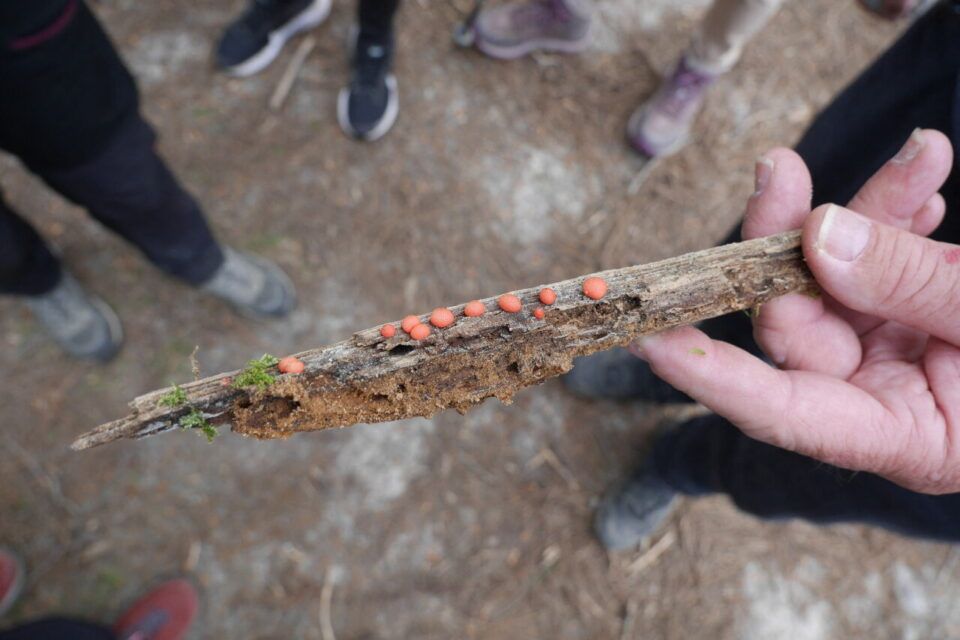
This would be Lycogala epidendrum, small organisms compared and often mistaken for a fungus. According to Wikipedia, the Greek term Lycogala, “wolf’s milk” is a reference to the coral red color and an allusion to the she-wolf, a bloodthirsty animal which had to have red milk.
The specific epithet epidendrum comes from the Greek epi, “on”, and dendron, “tree”, in reference to this saprotrophic organism which lives on the dead wood of trees, hence its name Tree Lycogale.
Elegant Ischnure, beautiful lady
The Blue Lake loop takes you to the heart of the Hostens wetlands, ideal for observing dragonflies and damselflies.

Above in the photo, a young lady met during this walk. This is an elegant Ischnure (Ischnura elegans).
Sensitive natural space
The Departmental Domain of Hostens and the Gât Mort lagoons (north east of Lake Bousquey) extend over 800 hectares and are a sensitive natural area (ENS) belonging to the Department of Gironde.
After the fires of summer 2022 and given the significant inherent risks, several parts of this space are still closed to the public.
Before planning your visit, find out about the accessible areas on the website https://www.gironde.fr/environnement/decouverte-des-espaces-naturels-de-gironde/domaine-dhostens
With Gilo, take a nature break!
Gilo, the meeting place for nature lovers, is a special four-page notebook published once a month in the paper editions of the newspapers Le Républicain Lot-et-Garonne (47) and Le Républicain Sud-Gironde (33) ( or in digital edition here: https://cutt.ly/pKtqX7i). Other articles, videos and photos can also be discovered for free on Facebook: Gilonature and Instagram: gilonature. Don’t hesitate to follow Gilo Nature! And once a week, receive a breath of fresh air of nature’s discoveries and curiosities by email. Register here, it’s free!
Follow all the news from your favorite cities and media by subscribing to Mon Actu.


